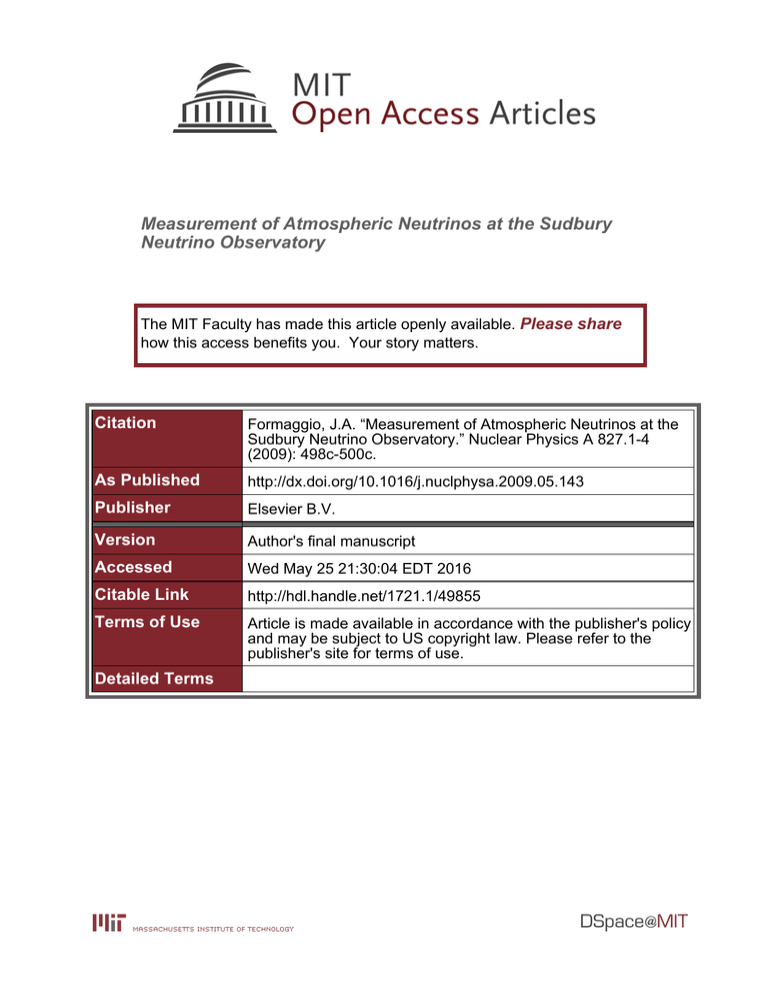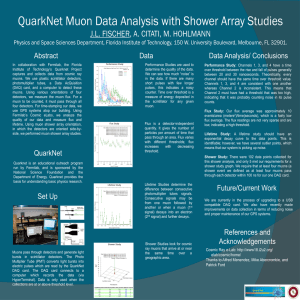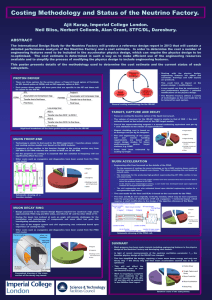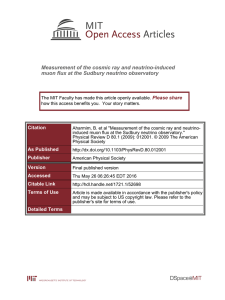Measurement of Atmospheric Neutrinos at the Sudbury Neutrino Observatory Please share
advertisement

Measurement of Atmospheric Neutrinos at the Sudbury Neutrino Observatory The MIT Faculty has made this article openly available. Please share how this access benefits you. Your story matters. Citation Formaggio, J.A. “Measurement of Atmospheric Neutrinos at the Sudbury Neutrino Observatory.” Nuclear Physics A 827.1-4 (2009): 498c-500c. As Published http://dx.doi.org/10.1016/j.nuclphysa.2009.05.143 Publisher Elsevier B.V. Version Author's final manuscript Accessed Wed May 25 21:30:04 EDT 2016 Citable Link http://hdl.handle.net/1721.1/49855 Terms of Use Article is made available in accordance with the publisher's policy and may be subject to US copyright law. Please refer to the publisher's site for terms of use. Detailed Terms Measurement of Atmospheric Neutrinos at the Sudbury Neutrino Observatory J. A. Formaggio, for the SNO Collaboration Laboratory for Nuclear Science, Massachusetts Institute of Technology, Cambridge MA 02139 Abstract The Sudbury Neutrino Observatory consists of a 1 kiloton heavy water Cherenkov detector able to detect and reconstruct high-energy muons created from cosmic ray showers and atmospheric neutrino interactions. By measuring the flux of through-going muons as a function of zenith angle, the SNO experiment can distinguish between the oscillated and un-oscillated portion of the neutrino flux. This report describes SNO’s measurements of the flux of cosmic ray muons and neutrino-induced muon flux at a depth of 5890 meters water equivalent. Key words: Neutrinos, cosmic rays, underground physics PACS: 14.60.Lm, 96.50.S-, 14.60.Pq Atmospheric neutrinos are produced from the decay of charged mesons created by the interactions of primary cosmic rays with the Earth’s atmosphere. Atmospheric neutrino interactions in this analysis are detected through the high energy muons created via the charged current interaction νµ + N → µ + X on materials that surround the detector. Although the latter process produces muons propagating at all zenith angles, overhead portions of the sky are typically dominated by cosmic-ray muons created in the Earth’s upper atmosphere. The Sudbury Neutrino Observatory (SNO) is located in the Vale-Inco Creighton mine in Ontario, Canada at a depth of 2.092 km (5890 ± 94 meters water equivalent) with a flat overburden[1]. The combination of large depth and flat overburden attenuates almost all cosmic-ray muons entering the detector at zenith angles less than cos θzenith = 0.4. Because of this depth, SNO is sensitive to neutrino-induced muons from a larger range of zenith angles than previous experiments. In addition, measuring the throughgoing muon flux as a function of zenith angle provides sensitivity to both the oscillated and un-oscillated portions of the atmospheric neutrino flux. Measuring the muon angular spectrum above this cutoff provides access to the flux of cosmic-ray muons created in the upper atmosphere. Preprint submitted to Elsevier 3 March 2009 The SNO detector has a nearly ideal spherically symmetric fiducial volume. The algorithm used to reconstruct muon candidates makes use of this symmetry in finding the best fit track. A two-tiered algorithm is used whereby a preliminary track is reconstructed which later serves as a seed for a more comprehensive fit to the muon candidate event. In the preliminary fit, the entrance position is determined by looking at the earliest hit PMTs, and the exit position is determined by the charge-weighted position of all fired PMTs. In our spherical geometry, the impact parameter is the distance from the center of the sphere to the midpoint of the line connecting the entrance and exit points. The fitter corrects the track fit for biases in charge collection and geometry, and provides a first estimate of the direction of the incoming muon. The first-order reconstructed track is then passed to a full likelihood fit to determine the muon track parameters to greater accuracy. The likelihood fit uses three distributions: (a) the number of detected photoelectrons, (b) the PMT charge distribution, and (c) the PMT timing distribution. This is important for impact parameter values close to the PMT support structure (bµ ≈ 830 cm). Approximately 87% (97%) of all simulated muons with an impact parameter of less than 830 cm reconstruct within 1◦ (2◦ ) of the true track direction; respectively. Studies also show that bias effects on the reconstructed impact parameter to be less than 4 cm. SNO collected data across three distinct operational phases. The data span from November 2, 1999 until November 28, 2006. Data were collected in discrete time intervals, or runs, that range from 30 minutes to 96 hours in length. The livetime collected across all three phases of the experiment is 1229 days. A combination of low and highlevel analysis cuts use reconstructed track parameters to isolate a pure through-going muon data set. Cuts have been optimized to remove instrumental backgrounds, poorly reconstructed muon tracks, and events where the muon originates from inside the fiducial volume (neutrino-induced contained events). These cuts define a total fiducial area of 216.42 m2 . The minimum (mean) muon energy needed to pass the selection criteria is 0.8 (2.6) GeV. The reconstructed cosmic-ray tracks, after all selection criteria are applied, exhibit a flat distribution versus impact area, as expected. The reconstruction efficiency is also robust to a number of changes in the optical and energy loss model of the reconstruction. Monte Carlo studies of cosmic-ray events that pass through the SNO detector show the total event selection cut efficiency to be 99.2% for through-going muons. The reconstruction algorithms used in the analysis are checked against data distributions and against data taken from an external muon tracking chamber installed above the SNO detector. SNO uses the Bartol group’s three-dimensional calculation of the atmospheric neutrino flux [2]. The neutrino energy spectrum is correlated with the primary H and He cosmic flux, both of which are strongly constrained by data. The uncertainties that dominate the neutrino energy distribution relate to the primary cosmic-ray energy spectrum, the π and K production ratio, and hadronic cross sections. Current estimates of the neutrino flux uncertainties are approximately ±15% and depend strongly on neutrino energy. Neutrino interactions in the rock surrounding the detector are simulated by the NUANCE v3 Monte Carlo neutrino event generator [3]. NUANCE includes a comprehensive model of neutrino cross sections applicable across a wide range of neutrino energies. Simulation of muon transport in the D2 O and H2 O and subsequent detector response is handled by the SNO Monte Carlo and Analysis (SNOMAN) code. Explicit muon energy loss mechanisms such as ionization, pair production, bremsstrahlung, muon capture and decay, and photonuclear interactions are all included in the simulation. 2 MACRO 10!8 LVD SNO 10!9 Number of Events Vertical Muon Intensity (µ cm!2 s!1 sr!1 ) 10!7 120 100 80 10!10 60 10!11 10!12 40 10!13 20 10!14 4000 6000 8000 10000 12000 14000 Slant Depth (km w.e.) 0 !1 !0.8 (a) !0.6 !0.4 !0.2 0 0.2 0.4 cos(!zenith ) (b) Fig. 1. Left: The flux of cosmic-ray muons that pass all cuts as a function standard rock depth. SNO data (filled circles) shown with best global fit intensity distribution model (dashed line) and data from LVD [4] (empty circles) and MACRO [5] (triangles) detectors. Right: The distribution of through-going neutrino-induced muons that pass all cuts as a function of zenith angle. Data (crosses) are shown with the best-fit MC spectra (solid box) and prediction with no neutrino oscillation (hashed boxes). A total of 76749 muon candidates passing all selection cuts are reconstructed with a zenith angle of 0.4 <cos θzenith < 1 for the 1229-day dataset. The data collected corresponds to an exposure of 2.30 × 1014 cm2 s. The total measured cosmic-ray muon flux at SNO, after correcting for acceptance, is (3.31 ± 0.01 (stat.) ± 0.09 (sys.)) × 10−10 µ/s/cm2 and its zenith distribution can be compared to results obtained by experiments such as LVD [4] and MACRO [5] (see Fig. 1(a)). A total of 514 events are recorded with −1 <cos θzenith < 0.4 (see Fig. 1(b)). The corresponding neutrinoinduced through-going muon flux below the horizon (cos θzenith < 0) and above the horizon (0 <cos θzenith < 0.4) are 2.10 ± 0.12(stat.) ± 0.08(sys.) × 10−13 cm−2 s−1 sr−1 and 3.31±0.23(stat.)±0.13(sys.)×10−13 cm−2 s−1 sr−1 , respectively. From the measured zenith angle distribution, one can extract the flux normalization and the neutrino mixing parameters. A maximum likelihood fit over the SNO-only data is performed and finds a flux normalization value of 1.22 ± 0.10 with respect to the Bartol three-dimensional atmospheric flux model and best fit neutrino oscillation parameters of ∆m2 of 2.6 × 10−3 eV2 and maximal mixing [6]. This is the first measurement of the neutrino-induced flux above the horizon in the angular regime where neutrino oscillations are not an important effect. The data reported in this paper can help constrain atmospheric flux models in the future. References [1] [2] [3] [4] [5] [6] SNO Collaboration, Nucl. Instrum. Meth. A449, 172 (2000). G. D. Barr et al. Phys. Rev. D 70, 023006 (2004). D. Casper, Nucl. Phys. Proc. Suppl. 112, 161 (2002). M. Aglietta et al., Phys. Rev. D58, 092005 (1998). M. Ambrosio et al., Phys. Rev. D 52(7), 3793 (1995). SNO Collaboration, arXiv:0902.2776 [hep-ex] (submitted to Phys. Rev. D). 3






